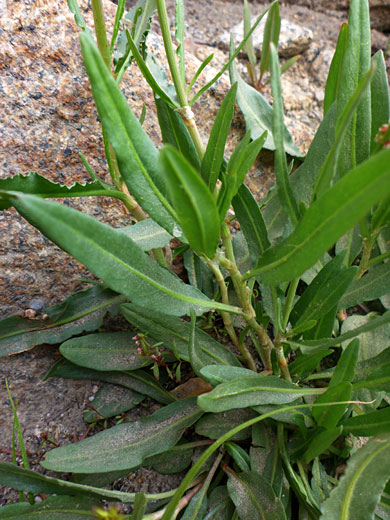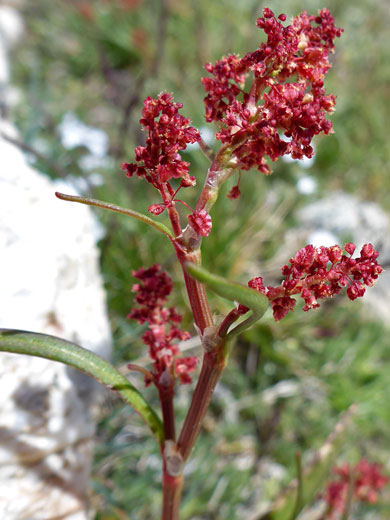Common name:
California dock
Family:
Scientific name:
Rumex californicus
Main flower color:
Range:
California to Arizona and Colorado, and states to the north
Height:
Up to 2 feet
Habitat:
Streambanks, moist meadows, wet places, from sea level to 11,500 feet
Leaves:
Blades are narrowly lanceolate to narrowly oblanceolate, up to 4 inches long and 1.2 inches wide, on stalks up to 1 inch
Season:
May to September
Rumex californicus is most widespread in the Sierra Nevada and the hills of southern California, with smaller populations across most other western states.
All plant parts are hairless. The ribbed stems bear stalked leaves at the base and at alternate intervals along the stem, and are slightly zig-zagged between adjacent nodes. Stems may branch a few times, above the middle. Leaf bases taper gradually to the stalk. Leaves have a broad, lighter-colored midvein, and faint, pinnate side veins. Leaf margins may be slightly wavy towards the base but are otherwise straight.
Flowers are produced in short, elongated, relatively open clusters, along the upper half (or more) of the stem. Flowers are spreading to pendent, attached by slender, thread-like pedicels, and are arranged in whorls. Flowers are pinkish to light brown, becoming red as they mature. A single plant generally has both staminate and pistillate flowers.
All plant parts are hairless. The ribbed stems bear stalked leaves at the base and at alternate intervals along the stem, and are slightly zig-zagged between adjacent nodes. Stems may branch a few times, above the middle. Leaf bases taper gradually to the stalk. Leaves have a broad, lighter-colored midvein, and faint, pinnate side veins. Leaf margins may be slightly wavy towards the base but are otherwise straight.
Flowers are produced in short, elongated, relatively open clusters, along the upper half (or more) of the stem. Flowers are spreading to pendent, attached by slender, thread-like pedicels, and are arranged in whorls. Flowers are pinkish to light brown, becoming red as they mature. A single plant generally has both staminate and pistillate flowers.
All Contents © Copyright The American Southwest | Comments and Questions | Contribute | Site Map




